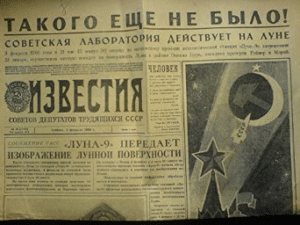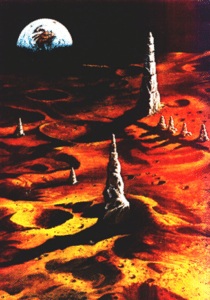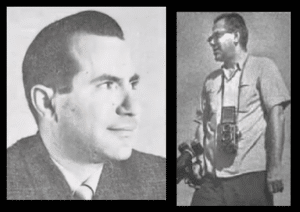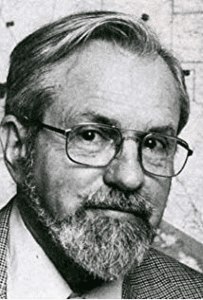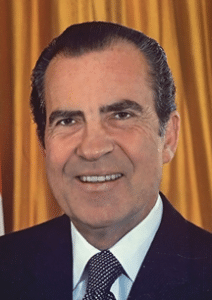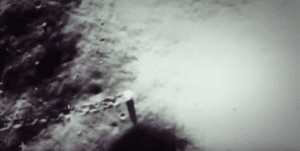By Dr. Raymond A. Keller, a.k.a. “Cosmic Ray,” the author of the international awards-winning “Venus Rising” Trilogy (Headline Books, Terra Alta, WV, 2015-2017), available on amazon.com while supplies last
Soviet newspaper Izvestiya, 5 February 1966, announces successful landing of Luna 9 robotic spacecraft on surface of the Moon.
Soviet Moon Probe
It’s hard to believe that next year will mark the fiftieth anniversary for humankind’s taking of its first steps on the Moon, the nearest celestial body to the Earth. Just three years before the historic Moon landing of the American Apollo 11 landing vehicle, space scientists the world over were still trying to figure out what the lunar surface was largely composed of.
Patriotic contactees like George Adamski and Howard Menger, who had been to the Moon courtesy of the Venusians, told personnel of the National Aeronautics and Space Administration (NASA) working on the proposed Moon shot that our astronauts would have nothing to fear in that regard, that they would find a hard and safe surface to walk on.
Perhaps the NASA scientists and technicians working on the Apollo program already knew about the lunar surface conditions; but they didn’t want to share that information with the Soviet scientists. After all, we Americans were in a race against time with the Soviets to put the first astronauts on the Moon and return them safely to Earth. If the Soviets wanted to know about the lunar surface, the head honchos at NASA probably decided it would be better if they wasted their own time and money to figure it all out. Why cut them any slack, and give them a leg up on us in the ongoing space race?
Just one month into 1966, the Soviet Union did just that. On 31 January the Soviet space program successfully launched their Luna 9 probe. It “soft landed” on the Moon on 3 February by employing its powerful retro-thrust braking rockets to set the 3,200 pound craft gently down. Of course, the Soviets amazed the entire world with this landing. Americans were beginning to wonder if NASA was going to maintain fidelity with the late president John F. Kennedy’s stated ambition for the United States of America to put the first astronauts on the Moon.
With the Luna 9, it was clear that the Soviets had taken a significant leap ahead of us in the space race. What was even more impressive was that the Luna 9 probe, after landing without any problems, was able to deploy a television camera and send live photos from the surface of the Moon. One of the biggest discoveries about the Moon revealed by this television transmission was the firm ground that the spacecraft touched down upon. This literally served to explode the famous theory of a dust-covered lunar surface in which any space vehicles would simply sink out of sight (Otto Binder, “Our Space Age” syndicated panels, 28 and 30 March 1966, Bell-McClure Syndicate, Paterson News, New Jersey).
Lunar “Pyramids” and “Spikes”
It became more than obvious that if the American populace and taxpayers were going to continue to stand behind NASA’s efforts to land astronauts on the Moon, that something should be done to at least catch up with, and maybe outdo, the Soviet Union’s great accomplishment in landing the Luna 9 on the Moon’s surface. The big breakthrough was revealed on Tuesday, 22 November 1966, when scientists at the Jet Propulsion Laboratory (JPL) in Pasadena, California, declared that their own Lunar Orbiter 2 had taken photographs of what appeared to be “pyramids on the Moon,” along with other “spike-like objects or obelisks that bore a remarkable resemblance to the Washington Monument.”
This is an artist’s conception of the United States Lunar Orbiter 2 discovery of strange pyramid and spike formations on the lunar surface. Source: Argosy magazine, August 1970.
A spokesperson for the JPL announced that, “Unusual mounds that appear like tall, skinny pyramids” turned up in one of the photographs among the first batches of the Lunar Orbiter 2 photographs. The photograph with the pyramids was enlarged five times and showed an area of about 750-by-550 feet. It represented the fourth of 13 potential landing sites for American astronauts slotted for exploring the lunar surface. The unique photograph was forwarded to NASA by the JPL. A spokesman for NASA noted that the area in question had about “six protuberances with the largest appearing to be about 50 feet wide at the base and 40-to-75 feet high.” The spokesman added that, “Some of the smaller ones look like upside down ice cream cones. I’ve never seen anything like it before.”
By way of explanation, the NASA spokesman declared that, “At the same time that the Orbiter 2 was photographing the area, the Sun was about 11 degrees above the lunar horizon during the sunrise phase of the Moon’s two-week long ‘day.’ This accounts for the long shadows,” the spokesman asserted, hoping that his conjecture would suffice for the members of the press corps present for his Lunar Orbiter 2 mission briefing.
The spokesman rambled on: “The striking shadow-casting protuberances are naturally occurring features on the lunar surface. They looked indigenous to the Moon and are spaced at random.” He also stated that a “determination of the precise height of the protuberances would only be possible after ground slope measurements had been made,” additionally noting that, “Some of the smaller protuberances in the cratered upland basin in the area called the Sea of Tranquility appeared weather beaten and rounded”
The source for this information was a United Press International (UPI) report dated 22 November 1966, as published in the Wednesday, 23 November 1966 edition of the Philadelphia, Pennsylvania, Inquirer newspaper. Remember, this was almost three years before the launch of the Apollo 11 mission, whose destination was ultimately designated as the Sea of Tranquility, the location of these strange lunar protuberances and domes. Clearly, NASA officials were desirous to find out the true nature of these structures. It is doubtful they accepted the first premise offered of them being something “indigenous” to the Moon and spaced at random” insofar as the true height of each object could not be determined. Some of the objects were also purely conical in shape while others resembled obelisks. These are not naturally occurring shapes.
Some kind of fervent activity appeared to be taking place on the Moon. It might signal extraterrestrial construction on our own supposed “natural” satellite. Keep reading this site for Dr. Raymond Keller’s The Moon Is a Venusian Colony, Part II, where the “Cosmic Ray” reveals other unique lunar phenomena and demonstrates how the strange protuberances on the Moon actually stumped all of the JPL and NASA’s so-called lunar “experts.” Learn what key figures in the international ufology community were saying as NASA was preparing to launch the Apollo 11 and American astronauts would walk on the surface of the Moon. You can be sure our explorers were not alone up there.
The Moon Is a Venusian Colony, Part II
By Dr. Raymond A. Keller, a.k.a. “Cosmic Ray,” the author of the international awards-winning “Venus Rising” Trilogy (Headline Books, Terra Alta, WV, 2015-2017), available on amazon.com while supplies last
Pioneer ufologist and UFO photographer, August C. Roberts, is pictured above. August believed the Apollo Moon missions would reveal much about our mysterious Moon. Photos courtesy of Rense Radio, with second photo first appearing in 4 July 1969 issue of Allentown, Pennsylvania Morning Call newspaper, in Keller Venus files.
The contactees of the 1950s and early 1960s tried to tell us that the Moon was already colonized by extraterrestrials, mostly Venusians. August C. Roberts, a close associate of the New Jersey sign painter and contactee, Howard Menger, who claimed to have taken a ride to a Venusian base on the Moon in a flying saucer, was interviewed by Joan Wiessmann, a correspondent for the Morning Call newspaper of Allentown, Pennsylvania. The intriguing interview appeared in the Friday, 4 July 1969 edition of the newspaper, just two weeks and two days before astronaut Neil Armstrong became the first man to walk on the surface of the Moon. Wiessmann’s interview with Roberts is important because it reflected the then extant mindset of most ufologists about the space program and a perceived cover-up of the truth about the UFO phenomenon.
In the Wiessmann article entitled “Augie Wants Moon News,” Roberts is quoted as saying that, “The Moon landing should prove a lot of things. It will also prove some people liars.”
At the time of the interview, Roberts was living in Wayne Township, New Jersey. Roberts could hardly contain his enthusiasm for the projected 20 July Moon landing. He was anxious to see if the astronauts would find dome-like buildings on the surface of the Moon. Roberts was a photographer noted for his tremendous collection of UFO pictures. But the finest flying saucer photos in his collection came from his good friend, the contactee Howard Menger. The famous photographer explained that, “I know a chap, Howard Menger, who has some good pictures of what he claims are flying saucers.” Roberts added that, “Menger claims to have been on the Moon. I did a book with him titled ‘From Outer Space to You.’” This book was published by the Saucerian Press of Clarksburg, West Virginia, in 1959.
Roberts continued: “Menger says some people from Venus landed in his backyard at High Bridge, New Jersey, and took him for a ride to the Moon.” While Menger was hovering over the Moon in a Venusian scout ship, the pilot of the craft allowed him to take some photographs of dome-like buildings on the lunar surface. These he turned over to his friend and fellow UFO researcher August C. Roberts, long acknowledged as one of the world’s leading authorities when it came to taking photographs of unexplained aerial and space phenomena.
Enter Valiant Thor
Of Menger, Roberts commented that, “I know his story very well. I believe that Menger thinks he is telling the truth; but I don’t necessarily believe the story.” When reporter Wiessmann asked Roberts to elaborate on this, Roberts explained that once he was in attendance at a meeting where the sign painter, Menger, was addressing the members of a flying saucer club assembled at his High Bridge home. Menger allegedly told the membership that there was a man from Venus among them, although they weren’t quite sure who he was.
“I took pictures of an unusual-looking man and then had these reproduced,” said Roberts, also declaring that, “Nobody has stepped forward and disproved the story. Menger called him Valiant Thor.” These and other photographs from Roberts’ special collection have been widely publicized in almost every UFO journal ever since. Just recently, I published them along with Roberts’ official seal and typed comments as found on the back of each photograph on the Jeff Rense Radio website.
Back in 1969, most of Roberts’ photos remained in his “secret file,” then considered one of the largest archives of UFO pictures in the entire United States, if not the world. Those photographs of UFOs and alleged extraterrestrials not taken by Roberts were carefully copied by him from other special collections. Roberts also co-produced a full-length commercial movie about flying saucers with Dr. Frank Stranges, out in Van Nuys, California. The movie was a UFO documentary entitled, “Phenomena 7-7.”
August C. Roberts was musing prophetic when he declared that, “What I do today, the children of tomorrow will see in books and movies.” Now, 49 years later, prominent Hollywood movie director Craig Campobasso has succeeded in garnering sufficient financing to go ahead with the production of a full-blown feature film about Valiant Thor’s arrival and activities here on Earth from 1957-1960. The movie will be titled Stranger in the Pentagon and should be in theaters sometime late next year or into the beginning of 2020.
Roberts on the Condon Report
During the time of the interview, the United States government recently concluded an exhaustive study of UFOs. It was contracted to the University of Colorado at Boulder and headed up by the prominent physicist Dr. Edward U. Condon. The Colorado team was assigned the task of determining whether or not flying saucers as extraterrestrial spacecraft were actually coming to the Earth. The Air Force paid the University of Colorado slightly over $500,000 to study this matter in 1966; and the study formally concluded in November 1968. Their report, titled Scientific Study of Unidentified Flying Objects, was released in January 1969. It has commonly come to be known as the Condon Report. Of the final document, Roberts was not impressed. “The research group must be incompetent because they decided the saucers didn’t exist,” he assured Wiessmann.
The pioneering ufologist added that, “I have proof-positive that they do exist. The people never asked to look at my files. The flying saucers look like bell-type ships.”
Wiessmann wondered if Roberts had any problems with the government, being so knowledgeable about the flying saucers traversing our skies. The ufologist did admit that he was once escorted out of the Pentagon because and a companion called out some top government officials as “liars” with respect to some of their misleading remarks about the UFO phenomenon that they were making to the press.
“They told us that President Ike Eisenhower said the UFOs were only sunspots,” noted Roberts. He thought this was a dubious statement because he served as a plane spotter at a remote base of the Army Air Corps situated at a secret location in a mountainous section along the Mexican border in 1943. “At that time, I and the other enlisted men were amazed to see a huge orange object circle below us in the valley. I know what a sunspot looks like, and this object exhibited no resemblance to that type of phenomenon.”
Remarkable Career
In his long career in the burgeoning subject of ufology, Roberts noted that for 1969, the year of the Moon shot, “business is slow these days as far as UFOs are concerned.” He added that, “A few UFOs have been seen in foreign countries. But you know, the saucers are supposed to appear in cycles. I believe it’s every five years.” Roberts expounded on the close approach of Mars and other planets in the solar system, when UFO activity seems to peak. “But I don’t say this is true. I don’t subscribe to any space theory.” Like the great anomalist John A. Keel, who worked in close association with Roberts on several projects, the prominent UFO photographer thought that there might be some inter-dimensional aspect to the whole UFO scenario, although he couldn’t be sure. “I keep an open mind to the possibility of UFOs as coming from some unseen ultra-dimensional reality,” he declared.
Another prolific figure from the UFO community who worked with Roberts was Gray Barker, the publisher of the Saucerian Press in Clarksburg, West Virginia. Barker edited and published Howard Menger’s first book, From Outer Space to You. Barker also popularized the frequent appearance of the mysterious Men in Black to UFO experiencers. Barker accused these dark figures with silencing the voices of those participating in close encounters of the third kind, or contact with the flying saucer occupants, and thereby keeping the truth about UFOs from the public at large. But it was Gray Barker who said of Roberts that, “If anybody deserves to be honored as a flying saucer pioneer, that person is August C. Roberts. In the unfolding saucer drama, his name has become as familiar as those of George Adamski, Major Donald E. Keyhoe, Ray Palmer and others.”
Roberts served as photographic consultant for Gray Barker’s Saucerian Press, in addition to working for a time with Raymond Palmer and his line of mystic, flying saucer, science fiction and space magazines. Long associated with UFO contactee Dominick Lucchesi, also of New Jersey, they published one of the very first flying saucer magazines, Nexus. He has given assistance to practically every major researcher from the early days of ufology, and was doing the photographic layout on a UFO book with comic book, science fiction and space writer Otto Binder, right before Binder passed away in 1974 at his Chestertown, New York, home.
One of the most exciting moments in Roberts’ UFO career took place in 1952. He was positioned in a sky watch tower and actually snapped a photo of a saucer which appeared directly above New York City. The photograph was shown on television, in newspapers up and down the East Coast, and national magazines. Roberts even appeared on a major television news program in 1955 where he displayed the photograph, along with some others of UFOs that he had taken since 1952 on other occasions. His account of the sighting and photograph of the object, along with other UFO photos, were included in the Westinghouse time capsule buried at the conclusion of the 1964 New York World’s Fair. The capsule will not be opened until the year 6939. Hopefully, UFO disclosure will have come by then. But I suppose we shouldn’t hold our breath.
Another Moon Mystery
The discovery of mysterious obelisk and domed structures in the mountains to the north of the Sea of Tranquility on the surface of the Moon cinched the area as the first priority landing zone for the Apollo 11’s lunar excursion module. Astronomers at the Corralitos Observatory on a remote ranch in the desert north of Las Cruces, New Mexico, attached there by a special lunar phenomena investigations division of Northwestern University in Evanston, Illinois, were conducting a survey of the mountains and craters in and around the Sea of Tranquility just weeks prior to the Apollo 11 launch, when they reported a unique ultraviolet radiation in close vicinity to the proposed landing zone.
Back in July 1969, while co-editing the Flying Saucer Report out of Bedford, Ohio, I received a newspaper clipping from a subscriber in Arizona. It was dated 5 July 1969 and first appeared as an Associated Press dispatch in the Tucson Daily Citizen. Titled, “Scientists Find a Moon Mystery,” this news item detailed how a group of New Mexico astronomers recorded intermittent fluxes of radiation from a large crater not far from the proposed Tranquility landing site. They had been monitoring this radiation flux for the past two years. “We are detecting in the Aristarchus region on a lunar monthly basis an excess of blue or ultraviolet,” noted J. R. Dunlap, the resident director of the observatory.
Threat Assessment
President Richard M. Nixon was apprised of the situation at Aristarchus crater directly by Dunlap. “What you are telling me is certainly unprecedented, Dunlap. That this radiation threat is centered so close to our designated Apollo landing zone is worrisome to me. Do you think we should temporarily postpone the mission?” inquired Nixon.
The Corralitos facility director replied that, “Mr. President, I do not believe the radiation will threaten the Apollo 11 astronauts or future Moon landing crews.”
“Would it be prudent to select an alternate landing site?” asked the president.
Dunlap declared that, “I think that I should defer to the head of our astronomy department at Northwestern University for that, Dr. J. Allen Hynek. We are definitely dealing with something quite extraordinary at Aristarchus and the Tranquility region in general.”
“Yes, I know Hynek. I’ve consulted him before on similar occurrences in outer space,” remarked Nixon.
Hynek Briefs Nixon
The president’s secretary set up a secure telephone line for Nixon to speak directly to Hynek at Northwestern. The following is a summation of their conversation.
Nixon: Dr. Hynek, what’s going on at Aristarchus crater? We’re getting too close to launch with Apollo 11 to start making any mission deviations.
Hynek: From what my people at Corralitos are telling me, their observations of the ultraviolet radiation began while they were in the process of searching for information about some of the centuries-old phenomena on the Moon that have long baffled us in the astronomy community.
Nixon: What are we talking about here, Hynek? I know you’re my “Johnny on the Spot” for everything UFOs and paranormal. Are we talking about ET activity on the Moon? Don’t B.S. me, Hynek. I’m not John Q. Public that’s going to buy off on “swamp gas” or “Venus seen in some weather inversion,” or any other lame explanation, for that matter.
Hynek: I’d never B.S. you, Mr. President. You were right there in the White House when our first emissary showed up there. So there’s no bull shitting you, Mr. President.
Nixon: Glad we have that settled. So what’s up at this crater that I should know about?
Hynek: Our folks at Corralitos were charged by me to monitor the areas where this “red glow” has been consistently observed. I wanted them to watch for any such red glows in the area where our astronauts are planning to land.
Nixon: That seems wise, Hynek. Please continue.
Hynek: Well, these red glowing areas on the Moon have been observed by astronomers for at least four centuries. They’re called lunar transient events. But besides the red glow, our astronomers at Corralitos and other telescopes devoted to lunar observations have reported seeing temporary increases in the brightness at Aristarchus crater. It has changed colors in its pulsating brightness.
Nixon: We have our reasons to suspect saucer activity on the back side of the Moon; but I wasn’t aware of anything taking place on the side that always faces us.
Hynek: This is a definite concern, Mr. President, especially in light of the fact that it’s occurring now, right before our astronauts take off for that very region.
Nixon: So what have astronomers been doing about it? What more have you discovered, that I need to know about?
Hynek: As of a few days ago, the red glows have ceased. But they have been replaced by some quite pronounced emissions of ultraviolet radiation. Utilizing our 24-inch telescope at Corralitos, we couldn’t be sure if the atmosphere or something was interfering to produce it; and we could not duplicate our findings. Frankly, Mr. President, I’m not sure just what the hell is going on up there.
Nixon: Dr. Hynek, given the unusual energy fluxes at Tranquility Base as reported from Corralitos, is it your opinion that we need to change our landing zone to somewhere else?
Hynek: I think we will be OK to stick with Tranquility Base as our LZ. The radiation has been observed regularly since last fall. We have no doubt that the radiation is there. Something, or someone, is causing it. I don’t think we’ll be alone up there on the Moon. It might be prudent to keep our astronauts apprised of this. ET will allow us to land and make our observations. But anything we find out about their presence on the Moon will have to be hushed up. As news of some strange lights and radiation near Aristarchus have already reached the ears of some in the news media, I suggest we go with a press release declaring something like, “The lunar rocks are just giving off a natural fluorescence, akin to the same process that causes mineral specimens in museums to glow under ultraviolet or infrared light.”
Nixon: Do you really think the public is going to believe that?
Hynek: I certainly hope so. We are entering a new age with our Moon landing. ET may let us land on the Moon; but I doubt they will let us establish a continuing presence there.
The Aftermath
Following the success of the Apollo 11 Moon landing mission, both Dr. J. Allen Hynek and President Richard M. Nixon were asked for their opinions about extraterrestrials and UFOs at various news conferences. According to a 22 April 2009 article in the London, United Kingdom, Telegraph newspaper, this is what these two historic personages had to say on the matter:
Dr. J. Allen Hynek, Astronomy Department director, Northwestern University, Evanston, Illinois, at time of Apollo 11 Moon landing. See https://www.imdb.com/name/nm0405251/.
Dr. J. Allen Hynek: “When the long-awaited solution to the UFO problem comes, I believe that it will prove to be not merely the next small step in the march of science, but a mighty and totally unexpected quantum leap. We had a job to do, whether right or wrong, to keep the public from getting excited.”
President Richard M. Nixon was in his first year in office when the United States became the first nation to land men on the Moon and return them safely to Earth.
President Richard M. Nixon, in office 1969-1974: “I’m not at liberty to discuss the government’s knowledge of extraterrestrial UFOs at this time. I am still personally being briefed on the subject.”
The Moon Is a Venusian Colony, Part III
By Dr. Raymond A. Keller, a.k.a. “Cosmic Ray,” the author of the international awards-winning “Venus Rising” Trilogy (Headline Books, Terra Alta, WV, 2015-2017), available on amazon.com while supplies last
Viking Probes to Mars a Diversion
By the time that the United States Bicentennial was being celebrated in 1976, the world’s attention towards all matters extraterrestrial had been diverted to the Viking 1 and 2 Mars missions, which were scheduled to land on the Red Planet on 20 July and 3 September, respectively, of that year. The Viking probes were to scoop up Martian dirt and then heat it up in built-in ovens to determine whether or not microorganisms existed there. The results were inconclusive. Some were suggesting, however, that the Viking missions were just a diversion for keeping us from more closely observing strange occurrences taking place on the Moon, just short of 250,000 miles away versus Mars, that is, on average, about 140 million miles away.
Tracks lead to a spire near crater rim on the Moon. Photo from National Geographic magazine 2015 television documentary, “Aliens on the Moon.” Apollo 17 was launched on 17 December 1972 and was allegedly the last manned mission to the Moon. There are rumors of an Apollo 18 mission, where astronauts encountered extraterrestrials and were given a warning to take back to authorities on Earth, delineating areas of the Moon where future explorers were prohibited entry.
The Moon is Inhabited
In the seven years since the Apollo 11 mission, most Americans had moved on from paying even the slightest attention to the Moon, but not all. One of these consistently observing our closest celestial neighbor was former National Aeronautics and Space Administration (NASA) scientist and photographic analyst, the Harvard engineering graduate George H. Leonard. Making some pretty shocking claims about the Moon, Leonard backed these up by securing the original, massive prints of sundry classified photos taken by the various Apollo mission teams while in orbit or carrying out a reconnaissance of the lunar surface by foot or Moon buggy.
Leonard kept asserting that the Moon is inhabited. He compiled his photos in a wonderful book, Somebody Else Is on the Moon (Philadelphia, Pennsylvania: David McKay Company, Inc., 1976). Leonard’s book opened a floodgate. Many NASA personnel, currently employed, fired, or retired, came forward to declare that everything stated in Somebody Else Is on the Moon was thoroughly accurate. They were just sorry that they didn’t have the courage that Leonard displayed. They wished they had come out with full disclosures about what they had discovered about the Moon a lot sooner.
Despite official denials since hurled against Leonard and his book, the author accomplished much more than just spinning a fanciful theory. His exhaustive study and analysis of thousands of sundry Apollo missions’ Moon photographs presents a convincing case that not only does the Moon have life on it, but that it is inhabited by intelligent beings that arrived there long ago from other planets, both inside and outside of our solar system, and colonized it for the express purpose of monitoring the spiritual and technological progress of humankind down through the ages.
Leonard maintains that the evidence for the presence of alien beings on our Moon is everywhere to be found: on the surface, on the far side and near side, in the craters, in the maria (Latin for “seas,” but here indicative of vast lunar plains) and even in the lunar highlands. He believes that the extraterrestrials on the Moon have literally been changing its face with various construction projects underway for the longest, but undetermined times. Leonard held a sneaking suspicion that astronomical discoveries, like those mentioned in this series, triggered both the United States and Soviet Union’s Moon programs. They may really be not so much the manifestation of a space race as a “desperate cooperation.”
In Leonard’s book, extensive attention is paid to photographs of the mysterious structures mentioned in Parts I and II of this series. There is also a photograph of a massive piece of machinery measuring five miles in diameter. The object in question is clearly a machine, because gears and teeth are visible. Leonard speculated that if the Moon machine were dropped down on Manhattan, it would literally “obliterate everything from midtown to the bowery.” There are also huge “super-rigs” and “X-drones.” Apparently, these are employed in moving significant amounts of lunar regolith. In the photos, these mechanisms seem to be knocking down ridge lines, carving away at the rim of craters, and more or less altering the very shape of the lunar landscape.
There are also strange sprays of dirt, sand, and even water that have been seen and photographed spewing out from craters. Leonard wonders what else might be emerging from the Moon’s many craters. Similar sprays have been observed on Saturn’s small moon of Enceladus and Neptune’s largest natural satellite Triton. This orb is so big that astronomers speculate it is not a moon at all, but was once a planet on the edge of the Kuiper Belt that was captured by the gravitational pull of Neptune countless eons ago. These sprays on our Moon, Enceladus and Triton seem to be indicative of aquifers or underground seas, possible sources for extraterrestrial life.
It’s not just Leonard’s word versus the assertions of the whole NASA establishment that the Moon is a dead, lifeless orb. Leonard presents his readers with official photographs along with line drawings that help us to select the more intriguing details that he discovered, pinpointing the areas and features that have long puzzled astronomers and others in the world scientific community. NASA Plate 14 (designated 67-H-1135) clearly shows two long trails, 900 and 1,200 feet long. The objects that made these tracks are light-splashed by the Sun; so some details are blocked out. However, they clearly do not look like boulders or anything else in the surrounding area of the photograph.
Leonard speculates, “Do you know how much force it would take to set in motion a rock 75 feet across? Volcanic action might do it; but we have NASA’s word for the fact that the Moon, on the surface at least, is seismically quiet.” The engineer further explains that, “The smaller object in the photo- the one making the longer trail- came up out of a crater before it continued down the hill. Repeat: It came up out of a crater.”
The former NASA engineer also points out a “fascinating tread mark on the trail of one of the ‘boulders.’ There is also a symmetrical design on the ‘boulder’ itself.”
Two Engineers Share Moon Data
In my opinion, this Leonard’s Somebody Else Is on the Moon is one of the more important books that the ufologist should maintain in her or his personal research library. I know for a fact that many persons inside of NASA helped Leonard obtain the hard-to-find and often classified information that he needed to write this fantastic book of Moon revelations. He mentions one engineer with a doctorate in physics, informed on all aspects of the Moon missions and lunar and the obstacles that our astronauts would encounter in the lunar geology. Leonard dubs him with the pseudonym of Dr. Samuel Wittcomb. What follows is the summation of a conversation between Leonard and Wittcomb.
Leonard: What did you mean when you said the Moon had “giant tailors?”
Wittcomb: Well, you see a lot of wreckage on the Moon, don’t you?
Leonard: Agreed.
Wittcomb: That wreckage could have taken place a thousand years ago or millions of years ago.
Leonard: Right. But what does this mean?
Wittcomb: One argument the people use for the occupation-eons-ago theory is just that many of the artifacts we see are part of the wreckage. It’s easy to believe there were aliens once on the Moon, pulling big pieces together- and they weren’t finished?
Leonard: It would seem logical, then, that they are still around. They are still repairing. But where is it taking place?
Wittcomb: Several places, but I am surprised that you have not found them. Someone in the Jet Propulsion Lab (JPL) sketched some out for me. But I already knew they were there.
Of course, the engineer Leonard kept up his own investigation and found many more lunar anomalies on his own. One can appreciate Somebody Else Is on the Moon for its very capacity to cut through the official smokescreen surrounding our nearest celestial neighbor, opening our minds to an enigma of historic and profound proportions.
Some who have sought out this information under the Freedom of Information Act have run into brick walls. Here are the comments from the field investigator of a major UFO group, retired United States Army Command Sergeant Major Robert Dean at the Exopolitics Summit in Barcelona, Spain, in 2009:
“Ladies and gentlemen, my government, NASA, which many of us in the United States say stands for Never A Straight Answer, proceeded to erase 40 rolls of film of the Apollo Program — the flight to the Moon, the flight around the Moon, the landings on the Moon, the walking guys here and there. They erased, for Christ’s sake, 40 rolls of film of those events. Now we’re talking about several thousand individual frames that were taken that the so-called authorities determined that you did not have a right to see. Oh, they were ‘disruptive,’ ‘socially unacceptable,’ ‘politically unacceptable.’ I’ve become furious. I’m a retired Command Sergeant Major. I was never famous for having a lot of patience.”
In my own second book in the Venus Rising series, Final Countdown: Rockets to Venus (Terra Alta, West Virginia: Headline Books, 2017), I continue where Leonard left off and present you with more of the amazing United States and Soviet/Russian discoveries regarding the long-standing extraterrestrial presence on the Moon, especially with the Venusian colony Clarion on the hidden side that only a few select astronauts and contactees have enjoying the privilege of seeing.


